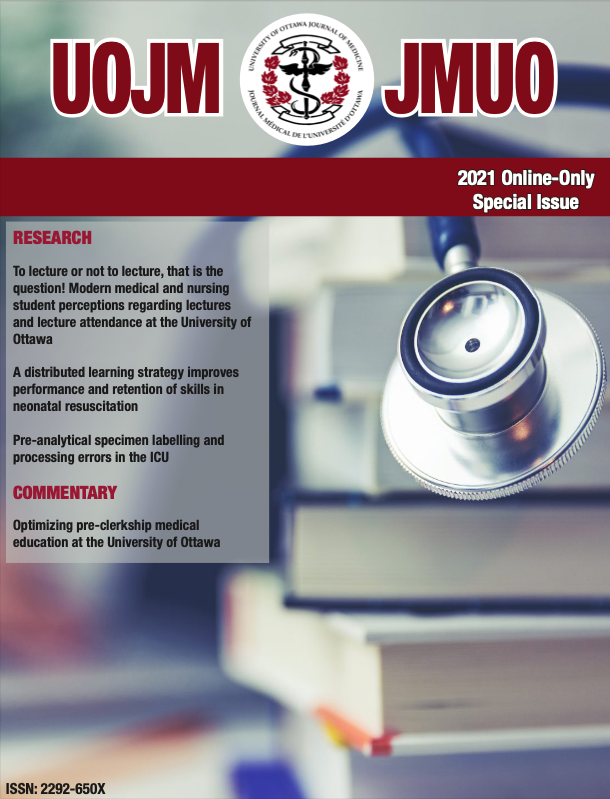To lecture or not to lecture, that is the question! Modern medical and nursing students' perceptions regarding lectures and lecture attendance at the University of Ottawa
To lecture or not to lecture, that is the question!
DOI :
https://doi.org/10.18192/uojm.v11iS5.4986Mots-clés :
Healthcare education, Traditional lectures, Medicine, Nursing, Student attendanceRésumé
Lecture has historically been a core method used for content delivery in healthcare profession education. However, lecture attendance has decreased within the recent generations of students. The current study focus was to assess the medical and nursing students’ perceptions regarding lecture attendance. To assist with this, second year medical (110/320) and nursing students (95/215) were requested to answer a 10-item survey. The results show that the top reasons why medical and nursing students attended lectures, respectively included: “lectures were mandatory” (81.8% and 68.8%), “socializing with peers” (68.2% and 30.1%), and “professor emphasized important points” (67.3% and 90.3%). While some reasons for students not attending lectures were that the lecture format was not effective (63.5% and 67.7%), students preferred to use recordings of the lectures (43.3% and 18.1%). Overall, 64.6% of medical students and 63.4% of nursing students agree that traditional lectures are an effective way of learning. Sixty two percent of medical students (62% n=68) of medical students stated that traditional lectures is their preferred method of learning compared to flipped classroom (27%), small group learning (30%), and online learning (31%). While (39%) of nursing students stated that traditional lectures is their preferred method of learning compared to flipped classroom (21.5% ), small group learning (3.2%), and online learning (7.4%). The results suggest that there is variability in students’ preferred learning style. While some prefer the face-to-face interaction with the professor, other students favour studying at their own pace. The majority of medical and nursing students think traditional lectures continue to play a major educational role.
Téléchargements
Fichiers supplémentaires
Publié-e
Numéro
Rubrique
Licence
© Safaa El Bialy, Dr, Dr, Dr, Dr 2022

Cette œuvre est sous licence Creative Commons Attribution - Pas d'Utilisation Commerciale - Pas de Modification 4.0 International.
- Les auteurs qui publient dans le JMUO gardent les droits d’auteur de leurs articles, incluant tous les brouillons et la copie finale publiée dans le journal
- Bien que le JMUO n’a pas les droits d’auteur des articles soumis, en acceptant de publier dans le JMUO, les auteurs donnent le droit au journal d’être les premiers à publier et à distribuer leurs articles.
- Par la suite, les auteurs peuvent soumettre leurs documents à d’autres publications, incluant des revues ou des livres, avec un remerciement de leur première publication dans le JMUO
- Des copies du JMUO seront distribuées à la fois sous format papier et en ligne, et tous les matériaux seront accessibles au public en ligne. Le journal n’a pas de responsabilité légale par rapport à la distribution publique du contenu.
- Prière de vous assurer que tous les auteurs, les coauteurs et les investigateurs
- Le contenu est rendu disponible sous licence Creative Commons Attribution - Pas d'Utilisation Commerciale - Pas de Modification 4.0 International.


